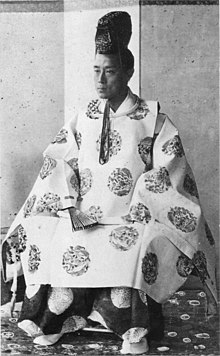Yoshinobu Tokugawa
| Tokugawa Yoshinobu | |
|---|---|

Tokugawa Yoshinobu as Shogun of Japan, c. 1867
|
|
| Member of the House of Peers | |
|
In office 1902–1910 |
|
| 15th Tokugawa Shogun | |
|
In office 29 August 1866 – 19 November 1867 |
|
| Monarch |
Emperor Kōmei Emperor Meiji |
| Preceded by | Tokugawa Iemochi |
| Succeeded by | position abolished |
| Personal details | |
| Born |
28 October 1837 Edo, Japan |
| Died | 22 November 1913 (aged 76) Bunkyō, Tokyo, Japan |
| Resting place | Yanaka Cemetery |
| Nationality | Japanese |
Tokugawa Yoshinobu (徳川 慶喜?) (also known as Keiki; October 28, 1837 – November 22, 1913) was the 15th and last shogun of the Tokugawa shogunate of Japan. He was part of a movement which aimed to reform the aging shogunate, but was ultimately unsuccessful. After resigning in late 1867, he went into retirement, and largely avoided the public eye for the rest of his life.
Tokugawa Yoshinobu was born in Edo, as the seventh son of Tokugawa Nariaki, daimyō of Mito. Mito was one of the gosanke, the three branch families of the Tokugawa clan which were eligible to be chosen as shogun. His birthname was Matsudaira Shichirōmaro. His mother, , was a member of the Arisugawa-no-miya, a cadet branch of the imperial family; through her, he was a third cousin (once removed) of the then Emperor, Ninkō. Shichirōmaro was brought up under strict, spartan supervision and tutelage. While his father Nariaki respected the second Mito Tokugawa Mitsukuni who had sent off the second and younger sons from Edo to Mito to raise them, Shichirōmaro was seven months old when he arrived in Mito in 1838. He was taught in the literary and martial arts, as well as receiving a solid education in the principles of politics and government at Kōdōkan.
At the instigation of his father, Shichirōmaro was adopted by the Hitotsubashi-Tokugawa family in order to have a better chance of succeeding to the shogunate and changed his first name to . He became family head in 1847, coming of age that year, receiving court rank and title, and taking the name Yoshinobu. Upon the death of the 13th shogun, Shogun Iesada, in 1858, Yoshinobu was nominated as a potential successor. His supporters touted his skill and efficiency in managing family affairs. However, the opposing faction, led by Ii Naosuke, won out. Their candidate, the young Tokugawa Yoshitomi, was chosen, and became the 14th shogun Iemochi. Soon after, during the Ansei Purge, Yoshinobu and others who supported him were placed under house arrest. Yoshinobu himself was made to retire from Hitotsubashi headship.
...
Wikipedia
